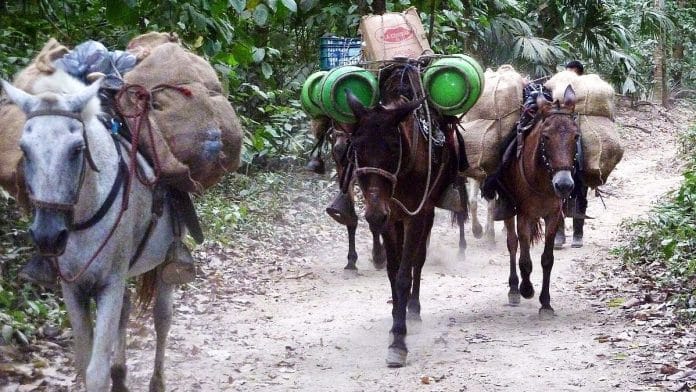New Delhi: After a delayed airport and a yet-to-open port, ‘all-weather allies’ China and Pakistan are now engaging in donkey diplomacy along the ‘jewel’ of their CPEC project—Gwadar. The port city now has Pakistan’s first $7 million slaughterhouse to cater to China’s demands for donkey meat, bones, and hides.
The new facility, operated by China’s Hangeng Trade Company, has attracted attention for its unusual nature in a country where donkeys are primarily used for transport and are sacred in some Islamic traditions.
The slaughterhouse’s operations come as part of an agreement between Pakistan and China to export donkey by-products, particularly hides, to the Chinese market in 2024.
The slaughterhouse, located in Gwadar, a key component of the $50 billion China-Pakistan Economic Corridor (CPEC), will process over 3,00,000 donkey hides annually. It will be essentially used for the production of ejiao, which is believed to enhance blood circulation, boost the immune system, and even prevent cancer.
Ejiao, derived from the collagen in donkey hides, has a market value of around $8 billion annually, with China being the primary consumer.
This has resulted in a growing demand for donkeys in China, where the equine population has dropped rom 11 million in 1990 to just under two million in 2021. Meanwhile, ejiao has shifted from being a niche luxury item to a widely accessible product, driving China to increasingly depend on imports from countries such as Pakistan and Afghanistan.
Also Read: Valentine’s to Champions Trophy—Atif Aslam joins the reels trend, impressing Pakistanis
Donkeys, demands and diplomacy
The decision to establish a slaughterhouse for donkeys in Gwadar marks a controversial shift in Pakistan’s agricultural landscape. Despite donkeys being prohibited for consumption in the Muslim-majority country, Pakistan’s donkey population continues to grow, with an estimated 5.5 million donkeys recorded in 2024—the highest in the world.
According to reports in the local media, Pakistan’s national assembly’s standing committee on food security—led by Rana Muhammad Hayat—was briefed on the project in January this year.
“The export of donkey by-products is more feasible than the live export of donkeys due to logistical challenges,” officials from Pakistan’s ministry of national food security and research reportedly said at the meeting.
The establishment of this slaughterhouse, however, has not been without controversy. Religious leaders and local residents in Gwadar have voiced opposition to the slaughter of donkeys, which are seen as an important mode of transportation in rural areas. Donkey meat is strictly forbidden in Islam, and concerns have been raised about the potential impact on Pakistan’s donkey population.
International concerns
The increasing reliance on donkey products to produce ejiao in China has sparked international concern about the sustainability of the donkey population. According to the Donkey Sanctuary, a UK-based charity, roughly 5.9 million donkeys are slaughtered globally each year to meet the growing demand for donkey-derived products, including ejiao.
The ejiao industry in China requires a minimum of 5.9 million donkey skins to keep up with the demand in the country, a 2023 report by University of Reading revealed.
China has previously turned to other African countries for donkey hides, but with the African Union imposing a ban on the export of donkey skins, China has increasingly looked to Pakistan for a sustainable supply. The establishment of a donkey slaughterhouse in Gwadar is expected to meet the growing demand.
However, the rise in the slaughter of donkeys has raised serious ethical and environmental concerns. As the donkey population in Pakistan and other countries declines, the threat of extinction for the species looms large. Experts also warn that the booming ejiao market could lead to increased theft and smuggling of donkeys, further exacerbating the problem.
According to the Pakistan Economic Survey (PES) 2023-24, Islamabad reported a rise in its donkey population from 5.5 million in the 2019-2020 fiscal year to 5.9 million in 2023-2024.
This isn’t Pakistan’s first attempt at exporting animal products prohibited for local consumption. In the 2015-16 financial year, Pakistan exported $2.8 million worth of swine meat to Afghanistan, primarily for NATO personnel stationed there. The central bank’s data reveals that Pakistan also exported $4,47,000 worth of pork to Afghanistan in 2016-17.
Despite the growing demand for donkey products in China, Islamic dietary laws prohibit the consumption of donkey meat in Pakistan, and the government has ensured that the meat will only be exported, not consumed domestically, local media reports stated.
Exaggerated, underused plans
Gwadar was once touted as a future commercial hub and a potential rival to Singapore’s shipping industry, but it has struggled to meet expectations. Despite the enormous infrastructure investments, the port and the new international airport remain underused, casting doubt on the city’s economic prospects.
The newly opened Gwadar airport, touted as a key development for the city, has failed to attract passengers due to limited demand. Despite being promoted as a major economic driver, Gwadar has struggled to meet expectations, with little commercial activity and insufficient infrastructure. A lack of stable power and transport links, as well as the ongoing conflict in Balochistan, has hindered growth.
Both the airport and Gwadar’s deep-sea port are central to the over $65 billion CPEC projects, which both nations see as pivotal to boosting trade and regional ties.
Situated strategically on the Arabian Sea, the airport is expected to complement the Gwadar port, which is key to CPEC’s vision of connecting China’s western Xinjiang region with Central Asia, the Middle East, and Africa via an extensive network of railways, highways, and pipelines.
(Edited by Sudha V)
Also Read: Zuckerberg afraid to fly over Pakistan. Someone tried to sentence him to death for blasphemy






